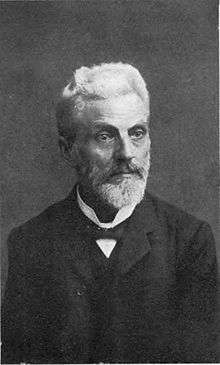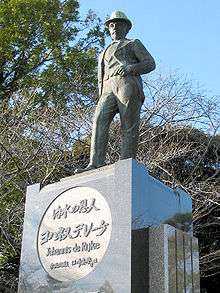Johannis de Rijke
Johannis de Rijke (December 5, 1842 – January 20, 1913) was a Dutch civil engineer and a foreign advisor to the Japanese government in Meiji period Japan.[1]
Johannis de Rijke | |
|---|---|
 | |
| Born | December 5, 1842 |
| Died | January 20, 1913 (aged 70) |
| Nationality | Dutch |
| Occupation | civil engineer |

Early life
De Rijke was born in Colijnsplaat on the island Noord-Beveland.[2] He was the third of seven children born to farmer and part-time dike worker Pieter de Rijke and his wife, Anna Catharina Liefbroer.[3] He obtained a position with the Dutch Ministry of the Interior as an apprentice to Jacobus Lebret, under whom he studied mathematics, earthwork construction, and hydraulic engineering practices.
Career
In 1865, De Rijke worked for Cornelis Johannes van Doorn building the Oranje lock which closed off the IJ from the Zuiderzee at Schellingwoude near Amsterdam. De Rijke was the chief construction foreman.[4] When Van Doorn was invited to travel to Japan in 1872, he encouraged De Rijke to join him in re-designing the port of Osaka.[3]
Japan
In September 1873, De Rijke arrived in Japan together with Van Doorn and George Arnold Escher. During the next thirty years, these three civil engineers developed a range of flood control and water management projects.[5] He improved the ports of Tokyo, Yokohama, Nagasaki, Ujina (Hiroshima), Hakata (Fukuoka),[4] Mikuni (Sakai) and Niigata.[3] His breakwater at the port of Yokkaichi is recognized by the Japanese government as an Important Cultural Property.
De Rijke also developed plans to improve riparian zones of several Japanese rivers. Notably, his groundwork and planning caused separation of the Kiso River, Nagara River and Ibi River near Nagoya, also known as the Kiso Three Rivers (木曽三川, Kiso Sansen).[6] Importantly, De Rijke was responsible for the construction of a tunnel channel from Lake Biwa to Kyoto.[3] He is also credited with building the Tokyo Kanda River sewer network.[1]
After 1891, De Rijke was appointed an Imperial officer of the Meiji Home Ministry, where he rose to the position of Vice Minister in this Japanese government bureaucracy.[7] He later served as an instructor in the Imperial College of Engineering.
China
In 1876, De Rijke traveled to Shanghai to help develop plans to improve the navigability of Huangpu river, a tributary of Yangtze River, which is important to Shanghai's international trade.[8]
In 1897, he returned to Shanghai for a second report of Huangpu river.
In 1901, he returned to China to participate in the Yellow River flood control project.[1]
In June 1906, he was officially appointed as the first chief engineer of the Whangpoo Conservancy Board. Before his return to the Netherlands in 1909, he carried out a number of riverway projects on Huangpu river, including the Wusong Jetty (built by the Huangpu's mouth) and the Gaoqiao new channel. His work successfully eliminated most of the shoals and achieved the preliminary goal of Huangpu channel improvement: the lowest water depth at Huangpu's mouth has been deepened from 15 ft to 21 ft, and in the Gaoqiao new channel from 2-3 ft to 19 ft. [9]
Later life
De Rijke was awarded the Order of the Sacred Treasures, 2nd class, and returned to the Netherlands in 1903.[4] In the Netherlands he was appointed Officer of the Order of Orange-Nassau and on January 13, 1911 to Knight in the Order of the Dutch Lion. In Belgium, he was knighted in the Order of Leopold
He died at the age of 70 in Amsterdam. He is buried in the Zorgvlied cemetery in Amsterdam.[3]
Honors
- Order of the Sacred Treasures, 1889 (4th class); 1892 (3rd class); 1903 (2nd class)[10]
- Order of Orange-Nassau, 1911.[2]
- Order of the Dutch Lion, 1913.[11]
- Order of Leopold (Belgium).[2]
See also
- Oyatoi gaikokujin
Notes
- Nussbaum, Louis Frédéric; et al. (2005). Japan Encyclopedia. De Rijke. p. 152. ISBN 0-674-01753-6.
- (in Dutch) Rijsbergen, Dennis. "Johannis de Rijke, ridder van de rijzende zon," Beroemde Zeeuwen. 27 August 2009; retrieved 2013-4-5.
- Pinedo, Danielle (January 13, 2000). "Oer-Hollands; In Japan is Johannis de Rijke nog altijd een beroemdheid" (in Dutch). NRC Handelsblad.
- Chubu Regional Construction Bureau, Ministry of Construction, Kiso River Lower Reaches Works Office. "The Father of the Riparian Work on the Kiso-Sansen: Johannis de Rijke". p. 2.CS1 maint: multiple names: authors list (link)
- "Johannis de Rijke: the Dutch Sensai", Radio Netherlands Archives, April 15, 2002
- Karan, Pradyumna Prasad. (2005). Japan in the 21st century: Environment, Economy, and Society, p. 136., p. 136, at Google Books
- Embassy of the Kingdom of the Netherlands in Tokyo Archived 2010-07-25 at the Wayback Machine, "Dutch-Japanese relations, Dutch Civil Engineers in the Meiji Period" Archived 2016-12-09 at the Wayback Machine; retrieved 2013-4-5.
- Yellow River Conservancy Commission, "Speech by Willem-Alexander, Prince of Orange," 2005; Archived May 22, 2011, at the Wayback Machine; retrieved 2013-4-5.
- Biography of Johannis de Rijke, 2011; A History of Shanghai Dredging Corporation (1905-1988) (上海航道局史,第一部), 文汇出版社, 1988, pp.16-21
- Chubu, p. 6.
- Noord-Beveland, Standbeelden Johannis de Rijke, Colijnsplaat; honor conferred January 17, 1913.
References
- Kamibayashi, Yoshiyuki. "Two Dutch Engineers and Improvements of Public Works in Japan," Proceedings of the Third International Congress on Construction History, Cottbus, May 2009
- Karan, Pradyumna Prasad. (2005). Japan in the 21st century: Environment, Economy, and Society. Lexington, Kentucky: University Press of Kentucky. ISBN 9780813123424; ISBN 9780813191188; OCLC 254187082
- Nussbaum, Louis Frédéric and Käthe Roth. (2005). Japan Encyclopedia. Cambridge: Harvard University Press. ISBN 978-0-674-01753-5; OCLC 48943301